Janet Fox's Blog, page 34
May 4, 2012
Guest Post: Debbie Davies "Look But Don't Touch"
Today I'm hosting author Debbie Davies on a singular aspect of romance...
Look but don’t touch – can this ever work in love?
“You can look but don’t touch” is a statement often uttered by frazzled parents trying to control their children. I have said this plenty of times to my toddler and it goes completely unheard.
 In a different context, though, would it be so easily ignored? What if someone was telling you to look but not to touch someone or something you loved? Someone you felt a burning need to be with, to speak to, to touch just once?
In a different context, though, would it be so easily ignored? What if someone was telling you to look but not to touch someone or something you loved? Someone you felt a burning need to be with, to speak to, to touch just once? Perhaps you are being told to look only because the object of your affection is forbidden to you. Some cultures have caste systems; some prejudices are openly discussed, while others are buried in our subconscious and we blindly follow them. We might see someone we could potentially love but we never dare to touch. Or do we?
An emotion as powerful as love encourages us to take risks. In Any Love But Mine this is the conflict facing Acacia. She has been banished and ordered to help others fall in love but to never allowed do so herself. But a life of loneliness is not one she can live, and now she has to choose: love and live with the risk of destruction or live and die from the pain of never knowing.
Any Love But Mine can be found at amazon.com and amazon.co.uk and you can also read more about it at http://www.goodreads.com/book/show/13541721-any-love-but-mine
Published on May 04, 2012 14:10
April 26, 2012
Debut Authors of the Class of 2k12: Sarvenaz Tash & THE MAPMAKER AND THE GHOST
Introducing another member of the extraordinary class of 2k12, debut author Sarvenaz Tash, author of THE MAPMAKER AND THE GHOST. Once again a fascinating title - I love magical realism! - and I'm thrilled to have Sarvenaz on my blog.
Congratulations on the publication of your novel, THE MAPMAKER AND THE GHOST. Can you tell us a bit about the story and what inspired it?
This is going to sound very Stephenie Meyer of me, but my main character really did come to me in a dream. I woke up with the name Goldenrod Moram in my head and wondered who would have that name: immediately, I thought of a young girl who was annoyed that her name sounded like she should be a fairy tale princess.
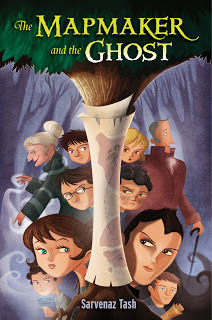 I was also inspired by things from my own childhood, namely The Goonies and the books of Roald Dahl and the very kid-centered magical realism vibe that they both share.
I was also inspired by things from my own childhood, namely The Goonies and the books of Roald Dahl and the very kid-centered magical realism vibe that they both share.I'm a big believer in dreams! How long have you been writing for children/teens? Have you written other books or is this your first effort?
I’ve long wanted to do it and I wrote some kid-oriented TV scripts in college. It was almost 5 years ago that I decided to focus on writing novels for kids by taking a Gotham writing class. THE MAPMAKER AND THE GHOST was technically my first effort, but I wrote another MG in between starting that one and selling it. I’ve also completed one more MG and have bits and pieces of other works, including an adult novel and a YA.
Can you describe your path to the publication of THE MAPMAKER AND THE GHOST?
I started taking Gotham Children’s Writing classes in 2007 and that’s where I started the first draft of THE MAPMAKER AND THE GHOST (to give you an idea of how different it was, there was no ghost in any of the first 26 drafts of this book – seriously).
In 2008, I attended the SCBWI conference in New York and I got some much-needed encouragement from superagent Jodi Reamer, who read two pages of the book and was very, very kind about them.
By 2009, the teacher at the Gotham class I was continuing to take had decided to become an agent. She (very excitingly) offered to take me on as a client. At that point, I had written MG #2, which is what we went out on submission with.
 MG #2 didn’t sell, but a few editors were interested in my writing and one, in particular, liked my voice in a humor blog I was keeping at the time. I suggested we submit my original humorous MG (MAPMAKER) to her, since the voice matched.
MG #2 didn’t sell, but a few editors were interested in my writing and one, in particular, liked my voice in a humor blog I was keeping at the time. I suggested we submit my original humorous MG (MAPMAKER) to her, since the voice matched. Although she liked the submission, it was too short for her to buy as is. So she very, very benevolently agreed to edit on spec with me. Incorporating her ingenious notes, I handed it back to her in March of 2010. And by August 2010, I had an offer!
What a great story. I love both the persistence you showed and the coincidences that worked. Do you have any advice for beginning writers?
If writing fulfills you and makes you happy; if even when you try not to, you can’t stop doing it; write and work hard and don’t be afraid to dream of it taking you places. But don’t do it as a means to an end. For it to be worthwhile, the writing itself should be enough of a joy (even if sometimes it’s the most horrifyingly frustrating thing in the world) -- everything else that might come with it is gravy!
Can you tell us something about your personal life – inspirations, plans for the future, goals, etc.?
Well, I got engaged a couple of months ago and am getting married in the spring. I’m finding wedding planning a welcome distraction from some of the anxieties of launching a book. J
Congratulations and best wishes to you both!! Do you have any new writing ventures underway?
I have a completed MG that’s out on submission and am (very slowly and painfully) chipping away at another MG and YA.
Do you have a website where readers can learn more about THE MAPMAKER AND THE GHOST?
Yes, indeed! They can find me at sarvenaztash.com.
Published on April 26, 2012 18:57
April 16, 2012
Debut Authors of the Class of 2k12: J. Anderson Coats & The Wicked and the Just
I'm so delighted to bring you another interview with a debut author of the Class of 2k12, J. Anderson Coats, about her novel THE WICKED AND THE JUST. This novel is just my cup of tea - historical - and that cover is so appealing!
Congratulationson the publication of your novel, THE WICKED AND THE JUST. I’m soexcited to be able to read historical fiction set in Wales. Can you tell us abit about the story and what inspired it?
THE WICKEDAND THE JUST takes place in 1293-1294in north Wales, ten years into English rule. Cecily is an unwilling transplant to the English walled townof Caernarvon, and she’d like nothing better than to go home. Gwenhwyfar, a Welsh servant in Cecily’snew house, would like nothing better than to see all the English go home. The ruling English impose harshrestrictions and taxation on the Welsh, and conditions in the countryside aregrowing desperate. The rumors ofrebellion might be Gwenhwyfar’s only salvation – and the last thing Cecily everhears.
 MedievalWales doesn’t get a lot of attention despite the fact that it was acomplicated, dynamic place. Thenative rulers managed to resist outright conquest by their English neighborsuntil 1283, but then the victorious English fast-tracked a series of castlesand walled towns to maintain control of the area and the people.
MedievalWales doesn’t get a lot of attention despite the fact that it was acomplicated, dynamic place. Thenative rulers managed to resist outright conquest by their English neighborsuntil 1283, but then the victorious English fast-tracked a series of castlesand walled towns to maintain control of the area and the people.What interested me was this question: Evenwhen granted a lot of special privileges - including significant tax breaks -how did English settlers live in a place where they were outnumbered twenty toone by a hostile, recently-subjugated population, and how did the Welsh live soclose to people who’d done the subjugating, especially given the burdens placedon them by their new masters?
How longhave you been writing for children/teens? Have you written other books or isthis your first effort?
I wrote myfirst novel at age thirteen. Itwas about a hundred pages long, typed, single-spaced, and it was reallybad. By age eighteen, I’d writtenfive more, each slightly less bad than the last. I started querying at age twenty, and I queried four novelsover ten years before I wrote and sold W/J. Ray Bradbury famously said that your first million wordsdon’t count. I think it was morelike two million for me. So whilethis definitely isn’t my first book, it’s the first one that’s ready to go intothe world.
Thirteen!! That's such an inspiration to young authors. Can youdescribe your path to the publication of THE WICKED AND THEJUST?
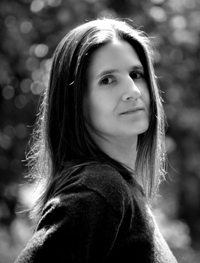 As Imentioned, I queried four different books over ten years, and I queried like itwas my second job. The Erin MurphyLiterary Agency was always at the top of my list, but they don’t takeunsolicited queries. I queriedlike crazy all around them – I have something like two shoeboxes filled withrejections - and I came close to getting an offer of representation a number oftimes, but I always kept one eye on EMLA’s requirements for any change.
As Imentioned, I queried four different books over ten years, and I queried like itwas my second job. The Erin MurphyLiterary Agency was always at the top of my list, but they don’t takeunsolicited queries. I queriedlike crazy all around them – I have something like two shoeboxes filled withrejections - and I came close to getting an offer of representation a number oftimes, but I always kept one eye on EMLA’s requirements for any change.So when Igot the chance to query Joan Paquette, I leaped on it. What followed was a sort of courtshipover nine months where she kept on asking for revisions and I kept making them,preparing for the eventual “no.” But that “no” never came, and the ink wasn’t quite dry on my agencycontract when W/J sold to Harcourt. It was something like ten days between being unagented and my first sale- quite a whirlwind!
Doyou have any advice for beginning writers?
Give yourself permission to write crap. Everyone’s first drafts suck. Your favorite writer? Her first drafts suck. Your other favorite writer? His first drafts suck. It’s more important to just write. Get it on the page and repeat after me: “It’s a firstdraft. It’s supposed tosuck.” You can fix things in a badly-writtenfirst draft, but it’s impossible to fix what doesn’t exist.
Can youtell us something about your personal life - inspirations, plans for thefuture, goals, etc.?
I’ve been told my origin story is somewhatinteresting. I had a kid at age19, a BA from a Seven Sisters college by age 22, a first master’s degree by 24,a second by 30, and a book contract by 32. The future is less knowable. Can I propose absurd yet awesome things like being hired by theNational Library of Wales or writing full time?
It sounds like you've lived several lives already. Doyou have any new writing ventures underway?
I’mworking on several projects right now. One is a companion novel to W/J which follows Maredydd ap Madog, whosefather is the ringleader of the rebellion of 1294, as he negotiates the futurehis father wants for him and the future he wants for himself. Another project is a standalone novelset in twelfth-century Wales about a warband, an abduction, a charismatic butmercurial king’s son and a girl who’s willing to do about anything for a chanceat a normal life.
Do youhave a website where readers can learn more about THE WICKED AND THE JUST?
I do! http://www.jandersoncoats.com - I also spend way too much time onFacebook, so feel free to stop by there as well!
Published on April 16, 2012 18:49
April 9, 2012
Highlights Founders Workshops: A Novel Experience
A few weeks ago I had the fabulous experience of serving asa Teaching Assistant, along with Karyn Henley (see previous post), at a Highlights Foundation WholeNovel Workshop . Our talented faculty were authors Kathi Appelt, Alan Gratz, JeanetteIngold, and editor Martha Mihalick. Sixteen students brought completed novelsto the workshop, with time to revise based on the individual feedback theyreceived from faculty mentors and the group input as we workshopped the firsttwenty pages.
I was deeply impressed by the experience, and wanted toshare some of it with you – including an interview (below) with author Helen Hemphill , who has taken the awesome responsibility of organizing and staffingthe faculty portion of Foundation events (you can find a schedule of upcoming events here.)
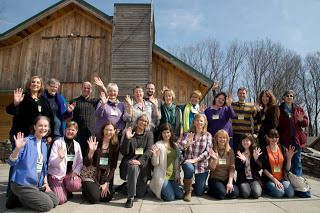 Our workshop group in mid-MarchThe workshop itself ran as smooth as silk. There was plentyof time between one-on-one consults and group workshops for participants towork in their cabins or to walk in the gorgeous countryside or to socialize.The TA's were given time to be available for consults and evenings were for themost part free.
Our workshop group in mid-MarchThe workshop itself ran as smooth as silk. There was plentyof time between one-on-one consults and group workshops for participants towork in their cabins or to walk in the gorgeous countryside or to socialize.The TA's were given time to be available for consults and evenings were for themost part free.The facility is lovely. Each participant is provided with acomfortable rustic but fully equipped cabin with its own bath (a main house wasundergoing renovations but will provide extra rooms soon.) A brand newconference center - the "Barn" - houses the kitchen and dining areas, plus extra space forlectures and workshop; there are lots of lovely nooks for hiding out andworking, reading, or meditating. The atmosphere lends itself to spiritualrenewal. And the food...the Highlights folks have gone to great lengths toprepare gourmet meals (and they will individualize for those with allergies ordietary needs), from the wine and hors d'oeuvres before dinner to the nourishingbreakfasts to the always-available snacks and coffee.
I heard rave reviews about the experience from participants,most of whom were unpublished and early in their writing careers. I saw manymake huge leaps of craft and commitment during our five days together.
I'm turning the floor over to Helen who graciously agreed toanswer a few questions.
Pleasetell us generally about the Highlights Founders Workshops – what your plans arefor 2012 and beyond.
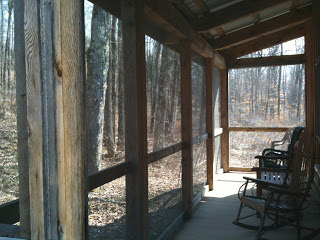 The porch of the cabin I shared with Karyn...lovely!TheFounders Workshops have been taking place since May 2000 at the former home ofthe Founders of Highlights for Children in northeastern Pennsylvania. The location is a beautiful farmcomplete with cozy cabins and a new conference center called The Barn thatopened last fall. This facilityhas allowed the Highlights Foundation to expand our workshop offerings forwriters and illustrators in 2012 with over three-dozen workshops during theyear. Our programming is broadbased with workshops for writers and illustrators at all levels of experienceand expertise. Our hope is tocontinue to refine and expand our workshop offerings so that we may serve ourmission to raise the level of the offering of writing and illustrating forchildren.
The porch of the cabin I shared with Karyn...lovely!TheFounders Workshops have been taking place since May 2000 at the former home ofthe Founders of Highlights for Children in northeastern Pennsylvania. The location is a beautiful farmcomplete with cozy cabins and a new conference center called The Barn thatopened last fall. This facilityhas allowed the Highlights Foundation to expand our workshop offerings forwriters and illustrators in 2012 with over three-dozen workshops during theyear. Our programming is broadbased with workshops for writers and illustrators at all levels of experienceand expertise. Our hope is tocontinue to refine and expand our workshop offerings so that we may serve ourmission to raise the level of the offering of writing and illustrating forchildren.Youhave a great mix of classes for beginners and pros, for fiction andnon-fiction, and for various genres. Will the template be the same for eachyear?
Weare working on our programming for 2013 and have some interesting new ideas instore for both writers and illustrators! The Barn gives us much more flexibility in our plans, but our aim is tooffer tracks in both fiction and nonfiction each year so that writers of alllevels may hone their skills. Of course, we will have specialized programmingfor illustrators as well! I'm excited about one of our possible offerings in2013--a literature-based weekend where teachers, critics, editors, librarians,and writers gather to discuss the elements of what makes a good book. I'm sure this weekend will offer upsome great discussion!
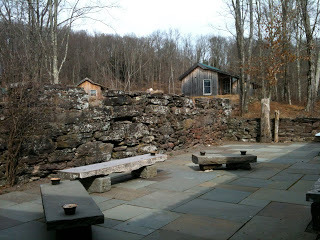 A sweet spot to sit outside the Barn, cabins in the background.Iwas so impressed with the thoughtful organization that went into planning theworkshop schedule. Does each workshop demand an individual approach?
A sweet spot to sit outside the Barn, cabins in the background.Iwas so impressed with the thoughtful organization that went into planning theworkshop schedule. Does each workshop demand an individual approach?TheHighlights Foundation is known for its exceptional level of hospitality and itsdedication to good teaching. Whilewe like to make it look easy, it takes a great deal of planning and detail tomake a workshop run well. We dotake an individual approach to each program to make sure the experience will beone of outstanding value to our attendees. We talk a lot about the details and try to anticipate theneeds and expectations of the writers and illustrators we serve.
Thegrounds are gorgeous. Kent (Brown, executive director of the HighlightsFoundation) mentioned plans in the works. Can you tell us what is coming forthe future?
We'renot quite ready to make a formal announcement, but there is more constructionhappening at the farm! Currently,the original farmhouse is being totally renovated for use as a smaller meetingspace. But we also have somebigger plans in the works. Yourreaders will just have to check out our web site, or better yet, come to aworkshop to see for themselves! A Founders Workshop is the perfect place tofocus on creative work, learn something new, and have a great time. A completelist of 2012 Founders Workshops is on our website at www.highlightsfoundation.org oryou can call Jo Lloyd for information at 570-253-1192.
Thanks so much Helen!
Published on April 09, 2012 19:42
April 2, 2012
Karyn Henley Guest Post: "Writers as Weight Lifters: Keeping Characters Off Balance"
A couple of weeks ago I had the great experience of being a teaching assistant at a Highlights Whole Novel Workshop (more on that next week.) But I had the singular good fortune to room with and TA beside award-winning YA author Karyn Henley.
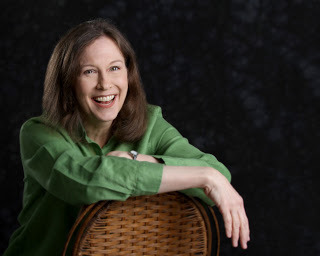 Karyn is one of the sweetest, kindest people I've met (and it's no easy task rooming with a complete stranger in what could be a stressful circumstance. This was the least stressful roomie situation ever.) She's also a Vermont College grad (go VCFA!) and a talented writer AND an accomplished and award-winning song writer. Her novel (BREATH OF ANGEL) is on my nightstand, calling to me, and her second novel (EYE OF THE SWORD; and check out the hunky guy on that cover...) launched while we were in Pennsylvania. Yay, Karyn!
Karyn is one of the sweetest, kindest people I've met (and it's no easy task rooming with a complete stranger in what could be a stressful circumstance. This was the least stressful roomie situation ever.) She's also a Vermont College grad (go VCFA!) and a talented writer AND an accomplished and award-winning song writer. Her novel (BREATH OF ANGEL) is on my nightstand, calling to me, and her second novel (EYE OF THE SWORD; and check out the hunky guy on that cover...) launched while we were in Pennsylvania. Yay, Karyn!
Karyn wrote me the following guest post and I'm delighted to share this fabulous offering.
Novel writers are the nicest cruel people I know. As I writethis, I'm at the Highlights Whole Novel Workshop with 21 other writers, allwonderfully nice people. But at this moment, with a morning free for writing,all these wonderfully nice writers are putting their characters in peril,pelting them with problems, and blocking their goals. Ah, but there's a reasonfor our madness. We're creating tension.
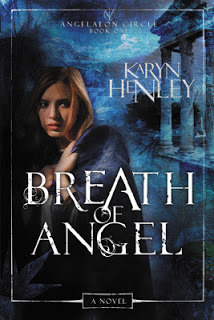 Agent
Donald Maass
is known for telling writers to put tension on every page. Keepthe reader in suspense. Raise the stakes. While these axioms are simple toremember, they're not so easy to do. Some writers are reluctant to hurt theirprotagonists, which creates a boring story. Some writers throw every problem inthe world at their characters, which makes the story either unbelievable and cartoonishor unrelenting and burdensome. So how do we create believable tension? Tensioncomes in different weights. Writers test the weights to find what will keep thecharacter – and the reader – off balance. The heaviest weights are fate-of-the-worldsuspense and life-and-death situations, although a child may experience theloss of a pet or an encounter with bullies as end-of-the-world heavy. Midweighttension comes from obstacles that delay a character or reveal a new problem to solve.Added together, several midweight obstacles can build heavy tension, especiallywith a clock ticking.
Agent
Donald Maass
is known for telling writers to put tension on every page. Keepthe reader in suspense. Raise the stakes. While these axioms are simple toremember, they're not so easy to do. Some writers are reluctant to hurt theirprotagonists, which creates a boring story. Some writers throw every problem inthe world at their characters, which makes the story either unbelievable and cartoonishor unrelenting and burdensome. So how do we create believable tension? Tensioncomes in different weights. Writers test the weights to find what will keep thecharacter – and the reader – off balance. The heaviest weights are fate-of-the-worldsuspense and life-and-death situations, although a child may experience theloss of a pet or an encounter with bullies as end-of-the-world heavy. Midweighttension comes from obstacles that delay a character or reveal a new problem to solve.Added together, several midweight obstacles can build heavy tension, especiallywith a clock ticking.
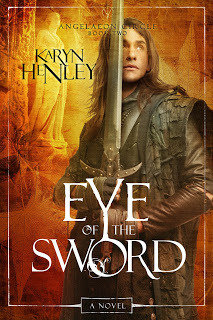 Weusually know that our stories need at least one heavy weight problem andseveral midweight obstacles, but we sometimes forget the lighter weights.That's where we get tension on every page. Tension doesn't have to come from afight or a chase or a disaster. Tension doesn't have to hit the page with a newproblem or a ticking clock. Tension doesn't even have to come from facing anantagonist. As long as it keeps the protagonist off balance, it's tension. Subtextbetween friends can convey tension. He wants to kiss her. She wants him to.Will they? In scene after scene they don't even touch. The tension builds. Oncethey kiss, the tension is released. So the writer keeps the tension going aslong as possible. Dialoguebetween friends can keep characters off balance. If one character says,"I'm applying for a job at Walgreen's," and her friend says,"Great idea," there's no tension. If her friend responds,"Why?" or argues, "You can't," there's tension.How-are-you-I'm-fine dialogue creates no tension. Delete it unless it covers anobvious, tense subtext, in which case the reader knows that the banter hidesdarker feelings and motives. Acharacter's goal is to bring some aspect of his life into balance. As you read,notice how writers deny their characters that balance. As you write, select theweights you need, and then shift the balance of your character's external orinternal world in every scene. Keep your characters – and readers – offbalance.
Weusually know that our stories need at least one heavy weight problem andseveral midweight obstacles, but we sometimes forget the lighter weights.That's where we get tension on every page. Tension doesn't have to come from afight or a chase or a disaster. Tension doesn't have to hit the page with a newproblem or a ticking clock. Tension doesn't even have to come from facing anantagonist. As long as it keeps the protagonist off balance, it's tension. Subtextbetween friends can convey tension. He wants to kiss her. She wants him to.Will they? In scene after scene they don't even touch. The tension builds. Oncethey kiss, the tension is released. So the writer keeps the tension going aslong as possible. Dialoguebetween friends can keep characters off balance. If one character says,"I'm applying for a job at Walgreen's," and her friend says,"Great idea," there's no tension. If her friend responds,"Why?" or argues, "You can't," there's tension.How-are-you-I'm-fine dialogue creates no tension. Delete it unless it covers anobvious, tense subtext, in which case the reader knows that the banter hidesdarker feelings and motives. Acharacter's goal is to bring some aspect of his life into balance. As you read,notice how writers deny their characters that balance. As you write, select theweights you need, and then shift the balance of your character's external orinternal world in every scene. Keep your characters – and readers – offbalance.Find out more about Karyn here.
Published on April 02, 2012 18:36
March 26, 2012
Michele Stegman Guest Post: "What makes a book compelling?"
Fellow romance author Michele Stegman graciously agreed to come by this week with the following guest post on a topic we all need, "What Makes a Book Compelling." Here's a bit about Michele: "Michele Stegman has loved history all her life. When she was studying history in graduateschool, one of her professors quipped that she put too much romance in herresearch papers. She decided to put in more romance andwrite historical romances.
Her Fortune seriesis following the adventures of the Fortune family through piracy and war in the1700's.Michele wasnever interested in writing contemporary novels. But one day she wasdriving along, thinking of nothing in particular, when the entire plot for MR. RIGHT'S BABY popped into her head. She couldn't stop thinkingabout it and finally decided it was a book that had to be written."
When Janet asked me to write about what makes a compellingbook for her blog, I had to do some thinking about it!
The answer to this question is long and complex and certainlycan't be covered in one brief blog! But here are a few quick observations.
1. Itcontains some universal truth.No matterwhat that truth is, it must be something we can relate to. And the more universal the truth, themore people it will appeal to. "Even selfish people can sometimes make greatsacrifices for someone else," or "Wealth does not equal happiness," or "Motherswill do anything to protect their children," will appeal to more people than,"It's nice to have a good car," or "Being pretty helps make you popular."
2. Itappeals to something deep within your personal psyche.
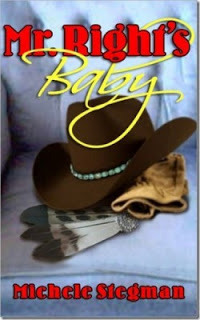 Most of ushave a favorite fairy tale. Formany of us, it is Cinderella. Welove stories where the heroine is rescued by a rich, handsome hero. For me, however, Cinderella was not myfavorite. Mine was Beauty and theBeast. Even as a very young child,first and second grade, I made friends with the kids no one else liked. It was as if I could feel theirpain. So when I find a story wherethe hero is dark and wounded, maybe even a little scary, and the heroine bringshim out of himself and heals him, I put it on my "keeper shelf."
Most of ushave a favorite fairy tale. Formany of us, it is Cinderella. Welove stories where the heroine is rescued by a rich, handsome hero. For me, however, Cinderella was not myfavorite. Mine was Beauty and theBeast. Even as a very young child,first and second grade, I made friends with the kids no one else liked. It was as if I could feel theirpain. So when I find a story wherethe hero is dark and wounded, maybe even a little scary, and the heroine bringshim out of himself and heals him, I put it on my "keeper shelf." Flowers From the Storm byLaura Kinsale, and A Rose in Winter by Kathleen Woodiwiss, are myfavorites.
A book witha theme that speaks deeply to you will appeal to you. Which explains why some people like a particular book andothers don't.
And bookscan appeal to you at one time, and not later. I have read books that I thought were wonderful. Years later, when I tried to rereadthem, there was just no appeal there for me. "Been there, done that." I think at the time, that book was just what I needed. It spoke to some current need that hasnow been healed or changed. Butthere are also books I have loved all my life, like the Beauty and the Beaststory.
3. Wecan relate to the characters. The longrunning cartoon series, The Simpsons, has been so popular because we can allrelate so well to the characters. Even Homer. We are allselfish and like to "pig out" sometimes. We have those qualities in us so we can relate. In Homer, they are exaggerated, butthey are in us all. Many of us, asreaders, of course, relate most closely to Lisa. She has few friends and she is always searching for a placewhere she can belong. We relate tothese characters because of their faults and weaknesses, not because of theirstrengths.
It's hardto relate to heroes and heroines who have no faults. Their faults don't have to be awful. They shouldn't be criminals or cheatsor kick puppies. But a heroine whohas self-doubts or is too over-confident is more appealing than a perfectwoman. Again, we relate tothe faults in characters, and not as much to their strengths.
4. StrongGMC.If youhaven't read Debra Dixon's GMC (Goal, Motivation, and Conflict) read itNOW.
I hateconflict and confrontation. Idon't like it when people fight. So I like things to run smoothly for my characters, as well. WRONG. Also BORING. The first couple of books I wrote got letters back from editors saying,"Not enough conflict." I thoughtthey meant the hero and heroine had to fight, argue, yell. Well, no. I didn't understand conflict at all.
JenniferCrusie said your characters can fight over a teacup, but it really isn't aboutthe teacup. What do they reallywant? What are they willing to doto get it? What stands in theirway? That's conflict! That's GMC.
5. Goodwriting.Goodwriting begins with the very first sentence of the book. I remember reading the first sentenceof Outlander and a shiver went down my spine. I knew this was going to be a great book. That first sentence set the tone forthe whole book.
When Ifirst started seriously submitting to editors, I hated that they wanted thefirst three chapters. I wanted tosubmit chapters 7, 9, and 12 because they were my best. That's where the "good stuff"happened. Well, duh, I soonrealized that the "good stuff" better start with the first sentence becausemost readers are not going to slog through six chapters of drek to get to thegood part.
For thefirst book I wrote that sold I had a really good scene in mind. It was going to be the last scene inthe book. But I kept tossing outstuff that came before that scene because I thought, "Well, I don't want towrite this stuff, why would anyone want to read it?" Finally, that good scene became the very first scene in thebook. I wanted to jump right intothe action so the first sentence of that book was, "One loop of the coarse ropethat bound Raven Winthrop to the mast of the pirate ship was about her neckchafing cruelly."
Of coursethere's a lot more to good writing than hooking the reader with the firstsentence, but this blog is long enough!
Thank you,Janet for hosting me today!
My pleasure! Informationabout Michele and her books can be found on her website where you can readexcerpts from each of her books: www.michelestegman.com.
Hereis a little blurb about Mr. Right's Baby and links tobuy the book:
"Hewanted to marry her. If she knew why, she just might walk away forever."
http://www.amazon.com/Mr-Rights-Baby-ebook/dp/B00655TAFA/ref=sr_1_1?s=digital-text&ie=UTF8&qid=1330019636&sr=1-1http://www.smashwords.com/books/view/102049
Published on March 26, 2012 15:26
March 21, 2012
Judith Graves Guest Post: "My Worst Fear as an Author"
Today I'm delighted to host my fellow2k10 author Judith Graves, whose second novel, SECOND SKIN, is just out! Judithand I are swapping guest posts this week, and I love her take on fear. Beingout there as an author is a brave move in an often hostile world...and Judithputs the perfect words to that edgy feeling.
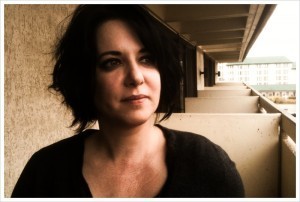 Being an artist, in any form, is atricky thing. You work relentlessly to hone your craft, dodge out of socialevents due to deadlines or a work-in-progress that refuses to cut you someslack, wake up in the middle of the night to jot down ideas/sketches/tunes, andthen your work is unleashed on the world.
Being an artist, in any form, is atricky thing. You work relentlessly to hone your craft, dodge out of socialevents due to deadlines or a work-in-progress that refuses to cut you someslack, wake up in the middle of the night to jot down ideas/sketches/tunes, andthen your work is unleashed on the world.A sometimes harsh, cruel world.
Suddenly what existed only in thesafety of your imagination is being interpreted by others, talked up or torndown, celebrated or mocked. You are no longer in control. For a creator, that'sone hell of a scary concept.
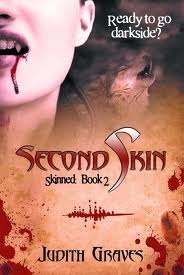 You may be tempted to clarifymisconceptions, or engage critics – to defend your baby…but that way leadsmadness. From an author's perspective, we don't know the personal biases,agendas, or histories that our readers will bring to the table when they beginat chapter one. Reading is a give and take – the author gives, and the readertakes out of the work what they are willing to see at that point in theirlives.
You may be tempted to clarifymisconceptions, or engage critics – to defend your baby…but that way leadsmadness. From an author's perspective, we don't know the personal biases,agendas, or histories that our readers will bring to the table when they beginat chapter one. Reading is a give and take – the author gives, and the readertakes out of the work what they are willing to see at that point in theirlives.Which may be far from the author'soriginal intent.
Art is subjective. Sometimes I enjoylistening to grunge tunes from the 90s and other days I skip over those songsin favour of something completely different. My likes and dislikes vary with mymood, what's happening that day, how I'm feeling physically.
I'll say it again. Art. Is. Subjective.
A negative review shouldn't prevent anauthor from continuing to write. I personally can't stand slasher flicks like Saw or Hostel, but there are tons of fans of the genre out there. They're notwrong. I'm not right.
We just have different preferences.
Artists put themselves in the line offire, invest themselves in their work and then share it with whoever may takethe time to stop and ponder the implications. Fear of rejection goes with theterritory. So does a thick, leathery hide.
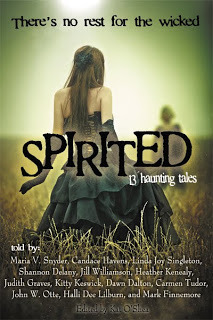 But sometimes, the feedback is good –great – beyond our dreams. Our voices are heard, joined by a chorus, andresound. Those moments keep us plugging away. They push back the fear and feedour souls.
But sometimes, the feedback is good –great – beyond our dreams. Our voices are heard, joined by a chorus, andresound. Those moments keep us plugging away. They push back the fear and feedour souls. The only thing to fear is…ourselves. Wealone can continue our quest to create, to share, and express ourselves in whatevermedium we gravitate toward. And so we might miss out on the occasional movienight, or lose an entire weekend writing about other worlds, because it's whatwe do. It's who we are.
Because being an artist is a scary,tricky, wonderful, magical thing.The collection SPIRITEDis just out as well....proceeds from the purchase of SPIRITED go to 826 National (a literacy charity) and it features the intro story to Judith's newsteampunk series (can't wait!), STRANGEWAYS: www.strangewaysnovels.com
And you can findout more about Judith at her website, www.judithgraves.com
Published on March 21, 2012 20:51
March 4, 2012
Marketing & Publicity for Authors: Part 5
In this last (for now) post in my marketing and publicityseries I'd like to address the little things that your "street team" can do tohelp you.
First, what is a street team?
 Your street team members are your dedicated readers: family,close friends, fellow authors, bloggers who have supported your work, readerswho can't wait to get their hands on your next book.
Your street team members are your dedicated readers: family,close friends, fellow authors, bloggers who have supported your work, readerswho can't wait to get their hands on your next book.A couple of recent articles (here's one) have pointed toresearch that suggests that "word of mouth" (aka, personal recommendations,whether from friends, librarians, or booksellers) is the number one way thatpopularity of a book spreads. Publishers can enhance a book's profile throughadvertising and promotion; but midlist, debut, or little-known authors can usepositive street cred to help with promotion. This is where your street teamcomes in.
What can your team do to help you? Here are ways – and allbut one take only minutes and cost nothing. And none of these are dishonorable(as in, falsifying reviews. Don't do that. Ever.)
1. Ifthey sincerely want to purchase a copy of your book, point them towardspre-ordering as soon as your book is posted for pre-order. Publishers basefirst print run numbers on pre-orders. You want as many books pre-sold aspossible to increase your chances of publisher support and word-of-mouth. (Thisis the only task that costs your street team members money!)2. Askyour street team if they would be willing to visit their local indie and talkwith the owner about your book. Outfit them with bookmarks and/or postcards toleave with the bookseller.3. Askthem to add your book to their Goodreads "want to read" list. Manybloggers/readers begin dedicated Goodreads' lists every year: i.e., "favorite YAreads;" "historical fiction for 2012." Your team members can like your book onthose lists, too.4. Askthem to go to the Amazon page for your book and "like" the book.5. Askthem to add tags to your book on its Amazon page. Tagging a book helps it toappear on appropriate suggested lists, so that when readers search for a newbook, yours might appear on the suggested list.
None of these suggestions will help a poorly written book –so your first job is to write as brilliantly as possible. Write from yourheart; polish and revise. There's a lot of competition in the marketplace andonly when you craft a book readers can't put down and can't wait to recommend,only then will you break out. But a little honest support from your street teamdoesn't hurt.
Best of luck - and please share any and all ideas that have worked for you!
Published on March 04, 2012 09:01
February 26, 2012
Marketing & Publicity for Authors: Part 4
I want to devote another post to marketing/publicity ideasbut first: since my last post on this subject I've fallen in love with Pinterest . I'm a visual person; for each of my novels I collect photos, maps,headshots, clothing ideas, etc. and put them on an idea board that inspires mewhile I work (for more on this idea board concept, see this terrific post by my friend Judith Graves.) Now I can post these same photos to Pinterest, and share them with myreaders. Finally – a place for me to display a vintage map or period gown,fabulous food or room decor! (Or, in the case of FORGIVEN , visuals depictingthe tragedy of slavery or earthquake devastation.) Check out what I mean here.
Now, more ideas:
When my first novel, FAITHFUL , came out I was eager touncover any marketing opportunities available. The first smart move I made wasjoining the Class of 2k . Originally FAITHFUL was slated for a fall 2009release; I joined the Class of 2k9 and made a number of friends there, whocontinue to be both real and virtual compatriots. When I was bumped to 2010the window of opportunity opened even wider, as I found another writing supportgroup in the Class of 2k10, whom I also count among my closest writing friends.
My advice to debut authors: seek out the opportunities tojoin groups like 2k, or the Debs, or theApocalypsies, because this is a lonelybusiness and community is critical to success.
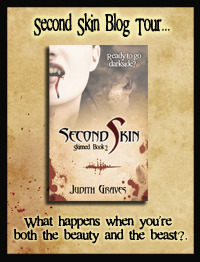 Judith's blog tour badgeThe second thing I did was to spend some of my advance on myown publicist (
Blue Slip Media
). They arranged a five-week blog tour, whichgave me a huge, bouncy springboard. They also helped line me up with signinggigs and raised my media profile. I feel it was money very well spent.
Judith's blog tour badgeThe second thing I did was to spend some of my advance on myown publicist (
Blue Slip Media
). They arranged a five-week blog tour, whichgave me a huge, bouncy springboard. They also helped line me up with signinggigs and raised my media profile. I feel it was money very well spent.If I were to suggest one single publicity item to you itwould be: blog tour. Bloggers who love books are our heroes. As an example ofgive and give again blog touring, I'll be hosting fellow 2k10 author JudithGraves here on March 22 as part of her SECOND SKIN blog tour.
And just in case you're thinking that a blog tour has to precede a book launch, here's a terrific idea to punch up a book that's been out for a while and give a boost to an upcoming book: Joy Preble has a blog tour going on for her second novel HAUNTED in time for the release of her third novel in the series, ANASTASIA FOREVER .
A recent article on the SCBWI blog inspired me to think about more out-of-the-box marketing ideas. I love thesetwo that Sara Wilson Etienne dreamed up for the release of HARBINGER :
setting up a website around acentral idea, theme, place, character – and making it come alive withinnovative marketing ideas - essentially creating an "alternate reality" for readersmaking the blog tour moreinteresting by focusing it around a theme (in her case, the artist character in her novel)
My friend Holly Cupala ( DON'T BREATHE A WORD ) is also a clever marketer, whotaught me the value of printing out a limited number of first chapter excerpts(complete with blurbs, publisher information and color cover) to send to aselection of independent booksellers. I made them myself for FAITHFUL, payingonly for the color cover printing, using a booklet form of standard paper folded in half and Wordlayout for a two-page spread (yes, it did take me a while to figure out the layout so that pages would print correctly.)
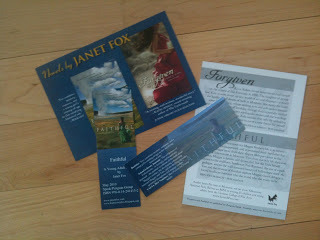 My bookmarks & postcards, front and backI also want to give a mention to my 2k10 sister DeniseJaden (
NEVER ENOUGH
), who is an extremely smart marketer. Here's a recent blog post inwhich she discusses marketing; I especially like that she's honest about thelack of success with postcards, but will do bookmarks again. I would agree –the one stellar piece of swag that I would invest in again and again is thebookmark. (Having said that, Blue Slip made me a fabulous postcard for myFORGIVEN release, featuring both of my book covers, with accolades and awardsand contact information, that has been a "best seller" and easy for me to handto booksellers and librarians at events and conferences.)
My bookmarks & postcards, front and backI also want to give a mention to my 2k10 sister DeniseJaden (
NEVER ENOUGH
), who is an extremely smart marketer. Here's a recent blog post inwhich she discusses marketing; I especially like that she's honest about thelack of success with postcards, but will do bookmarks again. I would agree –the one stellar piece of swag that I would invest in again and again is thebookmark. (Having said that, Blue Slip made me a fabulous postcard for myFORGIVEN release, featuring both of my book covers, with accolades and awardsand contact information, that has been a "best seller" and easy for me to handto booksellers and librarians at events and conferences.)I make my bookmarks myself using Word, with all relevant informationand cover on the front, and a bleed-out cover on the back over which I addaccolades, awards and quotes, maximizing all the space; I have them printed onthe heaviest card stock available at my local printer. Note that I leave just enough space for my signature on the back side of the bookmarks, which some like to collect.
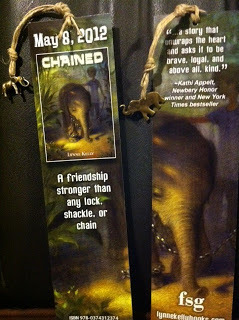 I love those little elephants!
I love those little elephants!Finally, check out this sweet idea from my friend Lynne Kelly ( CHAINED ) who made bookmarks with an elephant charm attachment – sodefinitely a "keeper"!! Here's how she did it:
For the bookmarksthemselves, I had them designed by JeffFielder, then I uploaded the designs and ordered them fromGotPrint.com. To make some of them more special, I ordered a variety ofelephant charms from Etsy sellers and attached them to the bookmarks with hemptwine. I'd tried a couple different kinds of string, like embroidery threadthat unraveled too easily, then found the roll of hemp in the beading sectionof Hobby Lobby.
Sweet and smart.
I hope some of these ideas help with your next round of marketing and publicity! Next time - how your "street team" can help you.
Published on February 26, 2012 08:44
February 19, 2012
Debut Authors of the Class of 2k12: AC Gaughen & SCARLET
I'm delighted to be back with another introduction to the Class of 2k12. Author AC Gaughen has crafted a wonderful twist on the legend of Robin Hood - one of my personal favorites - with her debut SCARLET...and don't you love that cover??
Congratulationson the publication of your novel, SCARLET. Can you tell us a bit about thestory and what inspired it?
SCARLETis a reimagining of the Robin Hood legend--with Will Scarlet as a very grumpy,knife wielding teen girl. She has a lot of dark secrets and holds to them very,very tight, but she also has people she wants to protect, all set in thebrutality and inequality of Britain's Middle Ages.
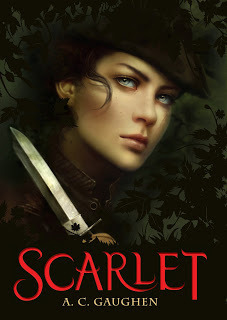 Honestly,Scarlet's voice is what inspired the story--it came out on a paper in gradschool and it took a really long time for me to figure out what the storywas. Once I realized who she was,her story just came out like a flood. It was really fun.
Honestly,Scarlet's voice is what inspired the story--it came out on a paper in gradschool and it took a really long time for me to figure out what the storywas. Once I realized who she was,her story just came out like a flood. It was really fun. Howlong have you been writing for children/teens? Have you written other books oris this your first effort?
Thisis what I've always wanted to be doing, so I've always been writing in thegenre since I was about 14. I haveabout 150 notebooks of other stories! I've had a few shorter pieces published, but this is my firstnovel.
Your story will be very inspiring to my readers. :) Canyou describe your path to the publication of SCARLET?
Ihad been trying to get an agent with various novels for about three yearsbefore SCARLET began catching the interest of several agents. About a month after I sent it out onsubmission I signed with my agent, and she sold it to Bloomsbury/Walker withinfive months after that. Fromthere, it's really a bizarre waiting game--I waited for about six months forthe contract to be finalized (eep! That's nerve-wracking), and then it's very start and stop--you'll wait,then get a revision that has to be done post haste, turn it in, wait for thenext step, which should be done with more urgency, etc. It's exciting!
Doyou have any advice for beginning writers?
SomethingI told myself before I got published and something I tell my self all the timestill--keep going. When you thinkyou have a great story, keep going until it's amazing, until it really breaksyour boundaries. When you thinkeveryone's rejecting you and this whole business is impossible to break into,keep going. When you're stressedand exhausted, just keep going.
That is truly the best advice. Canyou tell us something about your personal life – inspirations, plans for thefuture, goals, etc.?
Oneof the things that I find incredibly inspiring right now is the work I'm doingwith Boston GLOW , a non profit in Boston that I'm a board member of. One of the major initiatives I run withthem is an essay contest that encourages girls in underfunded school systems tocreate local, actionable change. It gives girls that aren't used to speaking up a new voice--and it'sjust incredibly humbling and uplifting.
Doyou have any new writing ventures underway?
I'vebeen working on another novel for a whiiiile now--longer than I've worked onany before. Honestly I'm not sureif it will ever see the light of day, but I think sometimes you have to writewithout the thought of any kind of publication. But then again, some times it helps your writing to think ofthe potential audience.
Doyou have a website where readers can learn more about SCARLET?
www.acgaughen.com Thanks Janet!!
Published on February 19, 2012 13:49



